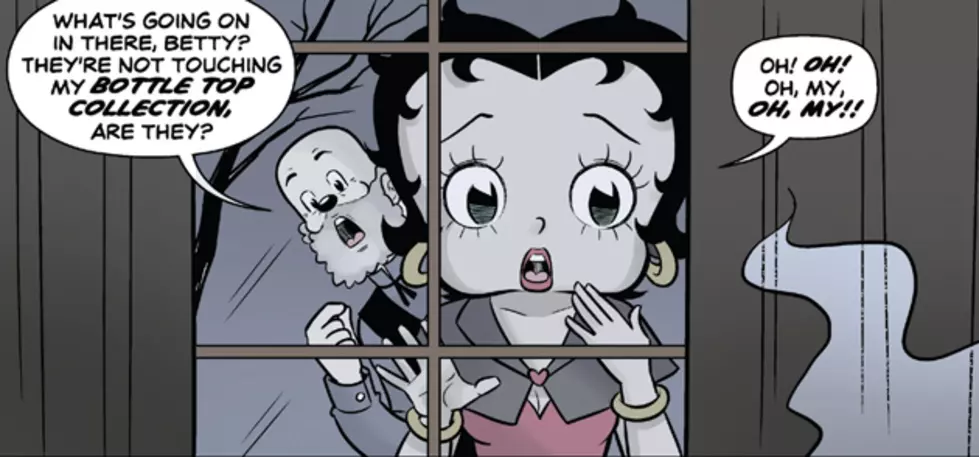
Made Of Pen And Ink: A Quick Primer On Betty Boop And Her World
Betty Boop #1, a new Dynamite comic from Roger Langridge and Gisèle Lagacé, brings an 86-year-old animated star to comics, and a whole world follows behind her. As a longtime fan, I'm excited not just to see Betty in a comic, but to see all her friends and co-stars. They're all products of Fleischer Studios, an animation house run by brothers Max and Dave Fleischer, which was also responsible for the original Popeye cartoons.
Betty Boop was a star in the early 1930s, before it had occurred to anyone that there should be rules about what you can do in cartoons. Her early shorts were filled with jazz music, sexual innuendo, and even slangy drug references. The Fleischers would sometimes team with musicians of the day, most notably Cab Calloway, to do cartoons that were essentially music videos starring Betty and friends. Then in 1934, the enforcement of the Hays Production Code forced cartoons and movies to clean up their act, and Betty never quite recovered. She got a longer dress and a new supporting cast, but her cartoons lost the anything-goes creativity that had been their hallmark. She was gone from screens by 1939, but clearly she's never been forgotten.
If you've picked up this comic only knowing Betty Boop from T-shirts and tattoos, you may be wondering who all these characters are and why everything seems a little weird. As an expert on this subject (which rarely comes up), I thought I'd provide a quick intro to Betty and her friends. I've links to some of the original cartoons, but keep in mind they're from nearly a century ago, and reflect the culture of their time, which can sometimes be alternately offensive and nonsensical to modern sensibilities.
Betty Boop
First Appearance: Dizzy Dishes (1930)
Betty began life as a dog. I mean literally, she had floppy ears and a little black nose. This made sense at the time, because she was created as a love interest for Bimbo the Dog, star of his own series of cartoons. She evolved into a human as she became a star in her own right.
Betty was a young, carefree flapper girl, the daughter of Jewish immigrants according to Minnie the Moocher. Sometimes she was accosted and had to defend herself, but just as often she went looking for adventure. And of course, she also loved to sing and dance.
Bimbo the Dog
First Appearance: Hot Dog (1930)
His name seems weird to us now, but at the time of his creation "bimbo" just meant a foolish person. It didn't become gendered until years later.
Bimbo starred in the "Talkartoons" series of shorts, so named because sound in film and cartoons was brand new and it was exciting that they could talk. He was an adventurer and a-ne'er-do well who was always getting in trouble. His best-remembered short is Bimbo's Initiation, in which he is trapped in the underground funhouse of a secret society that wants him to join. Seriously, watch that cartoon if you never have.
He became Betty Boop's boyfriend, even after she was a human. But under the Hays Code, even the most anthropomorphic dog dancing with a girl was considered too close to bestiality, and he promptly vanished. So it makes sense in the comic that he has a crush on Betty.
Koko the Clown
First Appearance: Experiment No. 1 (1918)
Full disclosure: I have a tattoo of Koko the Clown on my arm, so that's where I'm coming from.
Koko was originally Dave Fleischer in a clown suit, which Max Fleischer filmed and animated on top of, thus inventing rotoscoping.
Koko, still rotoscoped, starred in the "Out of the Inkwell" cartoons of the silent era. He reappeared in several Betty Boop cartoons, most notably Snow White, in which he's voiced by jazz legend Cab Calloway. He was always more of a sad clown than an effusively silly clown, but especially when he sang "St. James Infirmary Blues."
Mr. Finkle/Mr. Nobody
First Appearance: Betty Boop for President (1932)
Mr. Finkle, the angry boss in the comic, bares a striking resemblence to Mr. Nobody, Betty's political opponent from her 1932 run for the White House. The joke there was that he promised everything voters could want, but who would deliver on those promises? Nobody.
It turns out that in the preview that was released of the Betty Boop comic, this character actually was Mr. Nobody. My suspicion is that somebody else has a copyright on that name these days.
Pudgy
First Appearance: Betty Boop's Little Pal (1934)
Once the Hays Code outlawed Bimbo and confined Betty to a more domestic role, she got a pet dog to replace the dog she had dated.
Pudgy is less anthropomorphized than Bimbo, but he's still got a lot of personality, and even starred in some cartoons of his own. While I generally think that not much of value was added to Betty's world after 1934, I have to admit that Pudgy is pretty cute.
Grampy
First Appearance: Betty Boop and Grampy (1935)
Grampy, on the other hand, is kind of the worst. He's an inventor and general obnoxious old kook. He's also Betty's grandfather, presumably, although I don't think that was ever spelled out beyond her calling him Grampy.
Betty hanging out with her goofy grandpa is the perfect example of how cleaned-up and domesticated Betty became after her wilder years were forced to end. So it's interesting in the comic that taking care of Grampy is in conflict with her job in the nightclub, although she's currently managing to balance both. I'll be interested to see if that angle goes anywhere.
Sally Swing
First Appearance: Sally Swing (1938)
By 1938, Betty's days were numbered. It's not just that she'd been sanitized, it's that she was very much tied to the hot jazz and flapper culture that had been popular when she was created and wasn't anymore.
So Sally Swing was an attempt to create a replacement for Betty herself. Unfortunately, Sally didn't have much personality beyond a resemblance to Betty Grable and some amusing dance moves. So while Betty's run did soon come to an end, there were no Sally Swing solo cartoons to pick up the torch. In fact, it was Superman who became Fleischer Studios' next big cartoon star, but that's a whole other story.
We don't know much about her yet, but I like that Sally is in this comic. There aren't a ton of female characters in those old cartoons, and Betty's friends don't need to all be men (and dogs).
More From ComicsAlliance
![Jerrica And Rio Finally Talk It Out In ‘Jem And The Holograms’ #25 [Preview]](http://townsquare.media/site/622/files/2017/03/Jem000.png?w=980&q=75)


![12 Facts You May Not Have Known About Betty Boop [Love & Sex Week]](http://townsquare.media/site/622/files/2017/02/boop.jpg?w=980&q=75)



![Shana’s Milan Misadventure Continues In ‘Jem And The Holograms’ #21 [Exclusive Preview]](http://townsquare.media/site/622/files/2016/11/Jem21_featured.jpg?w=980&q=75)
![Hey! Ho! Let’s Go To Riverdale In ‘Archie Meets Ramones’ #1 [Preview]](http://townsquare.media/site/622/files/2016/09/Ramones01.jpg?w=980&q=75)
